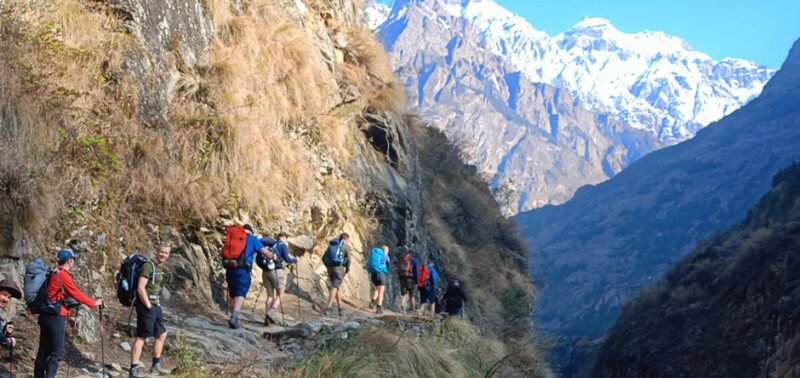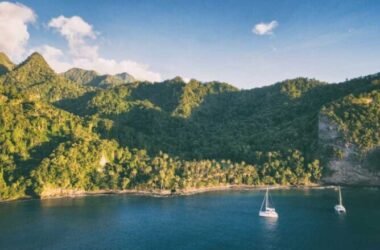Introduction
The Annapurna Base Camp (ABC) Trek stands out as one of the most iconic and rewarding trekking experiences in the Himalayas. Nestled in the heart of the Annapurna Conservation Area, this trail takes trekkers through lush forests, traditional Nepali villages, and up to the foot of the world’s 10th highest peak—Mt. Annapurna (8,091 meters). While the thought of trekking to such heights might seem daunting, the ABC trek is surprisingly suitable for beginners who come prepared.
This article is a complete, updated, and beginner-focused guide based on current trends, user queries, and gaps in existing content online. It brings together local expertise, on-ground experience, and trustworthy information, making it your go-to resource before setting off on this once-in-a-lifetime Himalayan adventure.
1.Understanding the Annapurna Base Camp Trek
The Annapurna Base Camp Trek is a moderate-level trek located in central Nepal. It usually takes between 7 to 12 days to complete, covering an approximate distance of 110 kilometers round-trip. The trek starts from the lowland towns like Nayapul or Jhinu Danda and ascends steadily through diverse landscapes until it culminates at the base camp, situated at an altitude of 4,130 meters.
The trail leads through a spectacular range of scenery—from subtropical forests and terraced farmlands to alpine meadows and glacial terrains. As you pass through villages like Ghandruk, Chhomrong, and Deurali, you’ll have the chance to interact with warm-hearted Gurung and Magar communities, who add a rich cultural flavor to the journey.
2.Preparing for the Trek
Despite being beginner-friendly, the ABC trek demands a certain level of physical readiness. Trekking 5 to 7 hours a day on uphill and downhill trails requires stamina and discipline. Beginners are advised to start cardiovascular training like walking, hiking, cycling, or swimming at least a month before the trek.
Additionally, acclimatization is critical. Gaining altitude too quickly can lead to Acute Mountain Sickness (AMS). A well-paced itinerary that includes acclimatization days will reduce risk. It’s equally important to hydrate well, avoid alcohol during the trek, and maintain a balanced diet.
Hiring a guide or joining a group, especially for first-timers, enhances safety and provides logistical support. A professional guide brings local knowledge, cultural context, and immediate help in case of altitude sickness or injury.
3.Essential Permits and Regulations
To trek to Annapurna Base Camp, you’ll need two mandatory permits:
- Annapurna Conservation Area Permit (ACAP): Required to enter the conservation zone.
- TIMS (Trekkers’ Information Management System) Card: Helps authorities monitor trekking activities for safety and data purposes.
These permits can be obtained in Kathmandu or Pokhara. If you’re using a trekking company, they will typically handle all permit arrangements. Independent trekkers must carry multiple photocopies of these documents as they may be checked at several checkpoints along the trail.
4.Best Time to Trek
The ideal times to embark on the ABC trek are:
- Spring (March to May): The forests are ablaze with blooming rhododendrons, and the weather is mild and clear.
- Autumn (September to November): This season offers the most stable weather and unobstructed mountain views, making it the most popular trekking period.
Trekking during winter (December to February) is possible but challenging due to snow and extreme cold at higher altitudes. The monsoon season (June to August) brings heavy rains, slippery trails, and frequent landslides, so it’s best avoided by beginners.
5.Accommodation and Meals
The ABC trek is well-served by teahouses, which are basic lodges offering food and shelter. You’ll find comfortable rooms (mostly twin-sharing) with shared bathrooms. Amenities become more limited as you ascend, with hot showers, charging ports, and Wi-Fi often costing extra.
Meals typically include Nepali dal bhat (rice, lentils, vegetables), pasta, noodles, soups, eggs, and occasional meat dishes. However, sticking to vegetarian options above 3,000 meters is recommended to avoid digestive problems. Bottled water is available but expensive; water purification tablets or a reusable filter bottle are eco-friendly alternatives.
6.Packing Essentials
Being properly equipped is crucial. Here’s what beginners should focus on bringing:
- Clothing: Think layers. Moisture-wicking base layers, fleece or down mid-layers, and waterproof outer layers work best. A warm hat, gloves, and thermal socks are essential for higher altitudes.
- Footwear: Invest in good-quality, ankle-supporting trekking boots and break them in before the trek.
- Gear: A backpack (30–40 liters), trekking poles, a headlamp, sunglasses, and a rain cover are essential.
- Personal items: Sunscreen, lip balm, wet wipes, a basic first aid kit, altitude pills, toiletries, and high-calorie snacks should be part of your kit.
Also, carry enough Nepali rupees from Pokhara, as there are no ATMs on the trail.
7.Health and Safety Considerations
One of the most critical aspects of trekking at high altitudes is managing health. The primary concern is Acute Mountain Sickness (AMS), which can affect anyone regardless of fitness. Initial symptoms like headache, nausea, and dizziness should never be ignored. If symptoms persist, the best remedy is immediate descent.
Travel insurance that covers trekking up to 5,000 meters and helicopter evacuation is essential. It may cost more, but it could save your life in emergencies. Beginners should also understand basic first aid and carry prescribed medicines for diarrhea, pain, or allergies.
Safe food choices, good hygiene, and moderate trekking paces further reduce the risk of illness or injury.
8.Cultural Etiquette and Responsible Trekking
The Annapurna region is home to diverse ethnic groups, primarily the Gurung and Magar communities. Understanding and respecting their culture enhances the experience. Dress modestly, especially in villages and religious sites. Always ask for permission before taking someone’s photograph.
Use local lodges, hire local guides, and purchase locally made goods to support the mountain economy. Moreover, practice Leave No Trace principles. Avoid single-use plastics, carry out your waste, and leave nature as you found it.
Conclusion
The Annapurna Base Camp Trek is a transformative experience—an extraordinary combination of natural grandeur, cultural richness, and personal challenge. With its moderate difficulty and excellent infrastructure, it remains one of the best Himalayan treks for beginners.
By preparing adequately, respecting local cultures, and trekking responsibly, you can make your ABC journey not just successful but meaningful. As you stand surrounded by towering peaks at the base camp, the sense of accomplishment, humility, and wonder will stay with you long after the snow has melted from your boots.









Lovart AI sounds like a game-changer for creative workflows-loving the natural language design prompts and Figma integration. Can’t wait to see how it streamlines the creative process. Lovart AI is definitely on my radar!
Your point of view caught my eye and was very interesting. Thanks. I have a question for you. https://accounts.binance.com/cs/register?ref=S5H7X3LP
Your article helped me a lot, is there any more related content? Thanks!
I don’t think the title of your article matches the content lol. Just kidding, mainly because I had some doubts after reading the article.
I don’t think the title of your article matches the content lol. Just kidding, mainly because I had some doubts after reading the article. https://www.binance.info/en-IN/register-person?ref=UM6SMJM3
Thank you for your sharing. I am worried that I lack creative ideas. It is your article that makes me full of hope. Thank you. But, I have a question, can you help me?
Can you be more specific about the content of your article? After reading it, I still have some doubts. Hope you can help me.